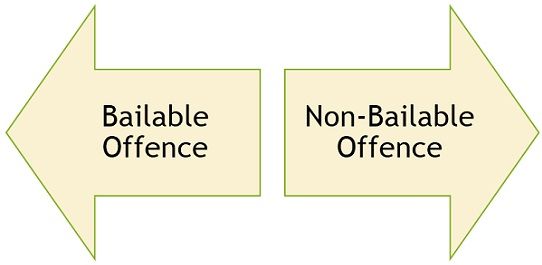 Under the Code of Criminal Procedure (CrPC), based on bail, offences can be classified as – bailable offences and non-bailable offences, wherein the former implies those offences in which bail can be granted to the accused. On the other hand, the latter signifies those offences in which bail cannot be granted in general circumstances.
Under the Code of Criminal Procedure (CrPC), based on bail, offences can be classified as – bailable offences and non-bailable offences, wherein the former implies those offences in which bail can be granted to the accused. On the other hand, the latter signifies those offences in which bail cannot be granted in general circumstances.
Bail is when the accused is freed from the custody of police officers and entrusting him to the sureties, provided the accused to be produced to answer the alleged charge at the stipulated date and time. So, bail is nothing but the freedom granted to the accused.
What is Offence?
Offence can be described as any act or omission which is punishable under any law, which is in force from time to time. Also, it covers any act, in relation to which any complaint has been lodged u/s 20 of Cattle Trespass Act, 1871.
Content: Bailable Offence Vs Non-Bailable Offence
Comparison Chart
| Basis for Comparison | Bailable Offence | Non-Bailable Offence |
|---|---|---|
| Meaning | A bailable Offence is one that is less serious in nature. It implies an offence in relation to which bail is available to the accused. | A non-bailable offence is an offence that is serious in nature and in relation to which bail is not available to the accused in general. |
| Quantum of Punishment | Punishment is for less than 3 years. | Punishment is for more than 3 years. |
| Grant of Bail | Matter of Right | Discretion of Court |
| Bail Granting authority | Investigating officer or officer in charge of the police station. | Judicial Magistrate or Judge |
| Bail Procedure | When the accused brings proper surety after his/her arrest, the investigating officer is bound to release the accused. | Investigating officer is required to present the accused before the magistrate within 24 hours of his/her arrest. At that time, he/she can make an application of bail to the magistrate either by himself or through a lawyer. |
| Bail bond | To be executed with or without producing surety. | To be executed with stringent conditions. |
Definition of Bailable Offence
As per law any offence indicated in the First Schedule as bailable, or the one made bailable by any other law which is in force from time to time, is called a bailable offence.
There are two parts of the First Schedule of CrPC, in which part I concerns itself with offences given under the Indian Penal Code, whereas part II is related to offences under other laws. Further, the last item of the First Schedule states that an offence can be called bailable, when it is punishable with imprisonment for less than 3 years or fine only.
Examples of Bailable Offence
- Bribery
- Public Nuisance
- Death by Rash or Negligent Act
- Simple Hurt
Right to be released on Bail
- When a person is arrested by the police without a warrant, the police must provide complete detail of the crime to the accused for which he/she has been arrested. Further, when the offence for which the person is arrested is bailable, the police must inform the accused that he/she has the right to be released on bail, after providing proper surety.
- When a person who is charged with a bailable offence is arrested by the police without a warrant and is ready to give bail then he/she has to be released on bail. The bail amount is to be decided either by the Court or by the investigating officer.
Under section 436 of the Criminal Procedure Code, provisions relating to bail in the case of bailable offence has been discussed. As per this section, when the person is charged with the commission of an offence that is bailable in nature, bail is the right of the accused because it casts a binding duty on the police officer in charge of the police station and the court as well to release the accused, when the offence is bailable.
Also Read: Difference Between Cognizable and Non-Cognizable Offence
Definition of Non-Bailable Offence
Non-bailable Offence refers to any offence which is not a bailable offence. As per law, it includes all such offences that are not included in the First Schedule of CrPC, as a bailable offence.
Moreover, the end of the second part of the First Schedule defines non-bailable offences like the ones which are punishable with death, life imprisonment or imprisonment for 7 years or more.
Examples of Non-Bailable Offence
- Rape
- Murder
- Dowry Death
- Attempt to murder
- Kidnapping
Right to be released on Bail
- It must be noted that when a person is accused of a commission of the non-bailable offence, he is not entitled to be released on bail, however, the bail can be granted as per the court’s discretion, subject to the provision under section 437 are fulfilled.
- Further, when a person is arrested by the police in connection to a non-bailable offence, such a person will not be given bail, if there seem reasonable grounds that the accused is guilty of the offence, which is punishable with death or life imprisonment.
- However, the accused of the non-bailable offence punishable with death or life imprisonment will be released on bail if the person is minor, i.e. below 16 years, woman, sick or infirm.
- Additionally, if at any point of the investigation, it comes to light to the Court that there are reasonable grounds to prove that the accused charged with the crime, has not committed it, then also the person may be released on bail, but only at the discretion of the Court, by executing the bond.
Also Read: Difference Between Detention and Arrest
Key Differences Between Bailable and Non-Bailable Offence
After developing a thorough understanding of these two, let’s move further to discuss the difference between bailable offence and non-bailable offence:
- Bailable Offence refers to offences that are less serious in nature. It implies an offence in which bail is available to the accused on the presentation of the surety. As against, Non-bailable offence includes those offences which are serious in nature and in which bail is not available to the accused.
- When it comes to the quantum of punishment, bailable offences attract punishment of 3 years maximum, whereas non-bailable offences attract punishment of more than 3 years. However, it is subject to certain exceptions when any contrary law exists in this regard.
- For Example: Suppose a person is accused of a bailable offence, and he/she is arrested or detained without warrant, that person has a right to be released on bail, but when that person is accused of a non-bailable offence, in such a case, the bail is upon the discretion of the authorities.
- In the case of a bailable offence, a grant of bail is a matter of right of the accused, whereas if we talk about a non-bailable offence grant of bail is the discretion of the court.
- In case of a bailable offence, the authority of granting bail is in the hands of investigating officer or officer in charge of the police station. Conversely, in a non-bailable offence, it is the Judicial Magistrate or Judge, who decides the bail to be granted or not.
- In a bailable offence, the accused is required to bring proper surety after his/her arrest, then only the investigating officer is bound to release the accused. In contrast, in a non-bailable offence, investigating officer is required to present the accused before the magistrate within 24 hours of his/her arrest. At that time, he/she can make an application of bail to the magistrate either by himself or through a lawyer.
- In a bailable offence, the bail bond is required to be executed with or without surety, whereas in the case of a non-bailable offence, the bail bond is to be executed with stringent conditions.
What is Bail?
Bail refers to the process of obtaining the temporary release of an accused who is charged with a crime, by making certain his attendance in the court in future for trial and compelling the accused to stay in the court’s jurisdiction, until he is found, innocent by the court.
Objective of Bail
- To stop the reiteration of the crime, which is charged to the accused.
- To obtain the attendance of the trial.
Criminal proceedings rely on the prima facie (i.e. at first instance) assumption of guilt. As well as there is a presumption of innocence in support of the accused. While bail acts as the presumption of innocence, the conditions of bail such as presentation in the court on the stipulated date and time act as the prima facie assumption of guilt.
The purposes of granting bail are:
- Appearance before the court
- Presentation of appeal
- Pending reference or revision
- Giving evidence
Also Read: Difference Between Bail and Bond
Procedure for Bail
| Bailable Offence | The accused needs to fill a form, specified in the first schedule of CrPC, and submit the same with the stipulated authority, then the Court will have to grant bail. |
| Non-Bailable Offence | The accused is required to fill the certain form, specified in the First Schedule of CrPC and submit the same, to apply for bail. Thereafter, it is the Court that decides to grant bail to the accused or reject the application. |
Conclusion
The Criminal Procedure Code (CrPC) has not given any reason regarding the basis on which classification between bailable and non-bailable offence has been made. So, there is a simple arbitrary classification of the offences covered under the two categories. Hence, one can rationally infer that all heinous crimes fall under the category of non-bailable offence, whereas those less serious ones are covered under bailable offence.






Leave a Reply